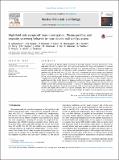| dc.contributor.author | Faust, I. | |
| dc.contributor.author | Mumgaard, R. | |
| dc.contributor.author | Reinke, M.L. | |
| dc.contributor.author | Labombard, Brian | |
| dc.contributor.author | Kuang, Adam QingYang | |
| dc.contributor.author | Brunner, Daniel Frederic | |
| dc.contributor.author | Faust, Ian Charles | |
| dc.contributor.author | Walk Jr, John R | |
| dc.contributor.author | Chilenski, Mark Alan | |
| dc.contributor.author | Lin, Ya | |
| dc.contributor.author | Wallace, Gregory Marriner | |
| dc.contributor.author | Whyte, Dennis G | |
| dc.contributor.author | Wolfe, Stephen M | |
| dc.contributor.author | Wukitch, Stephen James | |
| dc.contributor.author | Marmar, Earl S. | |
| dc.date.accessioned | 2018-07-25T18:42:13Z | |
| dc.date.available | 2018-07-25T18:42:13Z | |
| dc.date.issued | 2016-10 | |
| dc.identifier.issn | 2352-1791 | |
| dc.identifier.uri | http://hdl.handle.net/1721.1/117125 | |
| dc.description.abstract | New experiments on Alcator C-Mod reveal that the favorable impurity screening characteristics of the high-field side (HFS) scrape-off layer (SOL), previously reported for single null geometries, is retained in double null configurations, despite the formation of an extremely thin SOL. In balanced double-null, nitrogen injected locally into the HFS SOL is better screened by a factor of 2.5 compared to the same injection into the low field side (LFS) SOL. This result is insensitive to plasma current and Greenwald fraction. Nitrogen injected into the HFS SOL is not as well screened (only a factor of 1.5 improvement over LFS) in unbalanced double-null discharges, when the primary divertor is in the direction of B×∇B. In this configuration, impurity ‘plume’ emission patterns indicate that an opposing E × B drift competes with the parallel impurity flow to the divertor. In balanced double-null plasmas, the dispersal pattern exhibits a dominant E × B motion. Unbalanced discharges with the primary divertor opposite the direction of B×∇B exhibit excellent HFS screening characteristics – a factor of 5 enhancement compared to LFS. These data support the idea that future tokamaks should locate all RF actuators and close-fitting wall structures on the HFS and employ near-double-null magnetic topologies, both to precisely control plasma conditions at the antenna/plasma interface and to maximally mitigate the impact of local impurity sources arising from plasma-material interactions. Keywords:
Alcator C-Mod; Impurity screening; Double null; High field side scrape-off layer | en_US |
| dc.description.sponsorship | United States. Department of Energy (Contract DE-FC02-99ER54512) | en_US |
| dc.publisher | Elsevier BV | en_US |
| dc.relation.isversionof | http://dx.doi.org/10.1016/J.NME.2016.10.006 | en_US |
| dc.rights | Creative Commons Attribution-NonCommercial-NoDerivs License | en_US |
| dc.rights.uri | http://creativecommons.org/licenses/by-nc-nd/4.0/ | en_US |
| dc.source | Elsevier | en_US |
| dc.title | High-field side scrape-off layer investigation: Plasma profiles and impurity screening behavior in near-double-null configurations | en_US |
| dc.type | Article | en_US |
| dc.identifier.citation | LaBombard, B. et al. “High-Field Side Scrape-Off Layer Investigation: Plasma Profiles and Impurity Screening Behavior in Near-Double-Null Configurations.” Nuclear Materials and Energy 12 (August 2017): 139–147 © 2016 The Authors | en_US |
| dc.contributor.department | Massachusetts Institute of Technology. Department of Nuclear Science and Engineering | en_US |
| dc.contributor.department | Massachusetts Institute of Technology. Plasma Science and Fusion Center | en_US |
| dc.contributor.mitauthor | Labombard, Brian | |
| dc.contributor.mitauthor | Kuang, Adam QingYang | |
| dc.contributor.mitauthor | Brunner, Daniel Frederic | |
| dc.contributor.mitauthor | Faust, Ian Charles | |
| dc.contributor.mitauthor | Walk Jr, John R | |
| dc.contributor.mitauthor | Chilenski, Mark Alan | |
| dc.contributor.mitauthor | Lin, Ya | |
| dc.contributor.mitauthor | Marmar, Earl S | |
| dc.contributor.mitauthor | Wallace, Gregory Marriner | |
| dc.contributor.mitauthor | Whyte, Dennis G | |
| dc.contributor.mitauthor | Wolfe, Stephen M | |
| dc.contributor.mitauthor | Wukitch, Stephen James | |
| dc.relation.journal | Nuclear Materials and Energy | en_US |
| dc.eprint.version | Final published version | en_US |
| dc.type.uri | http://purl.org/eprint/type/JournalArticle | en_US |
| eprint.status | http://purl.org/eprint/status/PeerReviewed | en_US |
| dc.date.updated | 2018-07-20T17:54:10Z | |
| dspace.orderedauthors | LaBombard, B.; Kuang, A.Q.; Brunner, D.; Faust, I.; Mumgaard, R.; Reinke, M.L.; Terry, J.L.; Hughes, J.W.; Walk, J.; Chilenski, M.; Lin, Y.; Marmar, E.; Wallace, G.; Whyte, D.; Wolfe, S.; Wukitch, S. | en_US |
| dspace.embargo.terms | N | en_US |
| dc.identifier.orcid | https://orcid.org/0000-0002-7841-9261 | |
| dc.identifier.orcid | https://orcid.org/0000-0002-8917-2911 | |
| dc.identifier.orcid | https://orcid.org/0000-0002-8753-1124 | |
| dc.identifier.orcid | https://orcid.org/0000-0001-5049-2769 | |
| dc.identifier.orcid | https://orcid.org/0000-0001-8324-4227 | |
| dc.identifier.orcid | https://orcid.org/0000-0002-3616-8484 | |
| dc.identifier.orcid | https://orcid.org/0000-0002-5283-0546 | |
| dc.identifier.orcid | https://orcid.org/0000-0001-6303-3684 | |
| dc.identifier.orcid | https://orcid.org/0000-0002-9001-5606 | |
| mit.license | PUBLISHER_CC | en_US |
